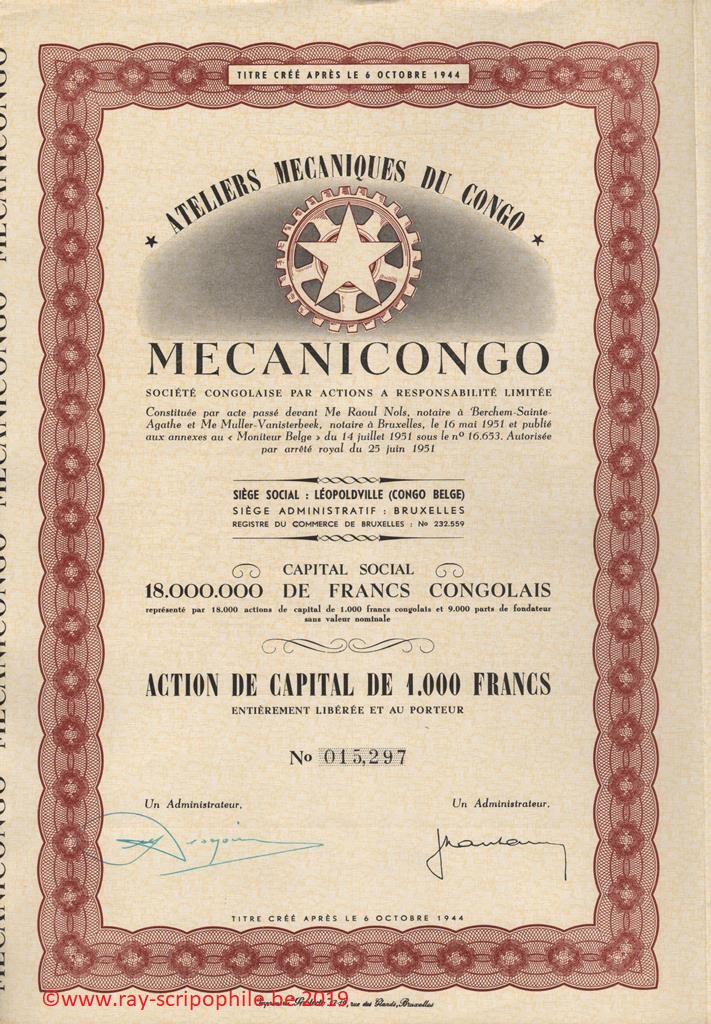ATELIERS MECANIQUES DU CONGO - MECANICONGO S.C.A.R.L.
Constitution
The Society Ateliers Mécaniques du Congo - MECANICONGO was created on May 16, 1951 with a capital of 18 million Congolese francs represented by 18,000 shares of capital of 1,000 Congolese francs and 9,000 founder's shares without designation of value. The registered office was established in Leopoldville and its administrative headquarters in Brussels.
The capital was subscribed in cash and fully paid up by the comparators :
- The Union des Industries, 8,400 shares
- The Compagnie Congolaise d'Entreprises et Réalisation Congoréal , 5,750 shares
- Automobiles Industrielle Brossel frères, Bovy et Pipe S.A., 1,250 shares
- Société Anglo-Franco-Belge des Ateliers de la Croyère, Seneffe and Godarville, 1,000 shares
- La Seneffoise S.A., 1,000 shares
- René Bidoul , 100 shares
- Alex Corbeau, 100 shares
- Edouard Desgain, 100 shares
- Yves de Brouwer, 100 shares
- Jacques Hautain, 100 shares
- Louis Zurstrassen, 100 shares
First Board of Directors
The Board of Directors, consisting of six directors, was represented by Mrs. Jacques Hautain, Chairman, Louis Zurstrassen, Edouard Desgain, René Bidoul, Alex Corbeau and Yves de Brouwer (12-(14/07/1951)-16653).
Object
The Company's main purpose was the manufacture, purchase, sale, factory assembly, maintenance and repair of all transport and traction equipment, all industrial or other engines, whether diesel, petrol or electric, and all mechanical machines, constituting capital or protective goods for industry or private use. The Company could also operate, in the form it deemed appropriate, any mechanical or transport equipment; it could apply for, obtain, acquire and use any patents, licenses and manufacturing processes. It could purchase, build, lease, rent any property, movable or immovable, equipment and installations, and carry out any operation likely to facilitate the achievement of its corporate purpose (1).
Modification and transformation of share capital
Several changes in capital will be made during the company's ten years of existence.
Among others, the EGM of May 31, 1960 decided to reduce the capital by 3 million and to reimburse the shareholders of this amount. This reimbursement was made in the form of a distribution among the shareholders of the 3,000 shares of the company Refami "Représentation et Fabrication de Matériel Industriel" held by MECANICONGO. The distribution was made by allocating one Refami share for every ten MECANICONGO shares (12-(22-23/07/1960)-22810).
In 1961, as a result of the changes, the capital of 20 million was converted into Belgian francs* represented by 37,000 shares, i.e. 7,000 preference shares and 30,000 ordinary shares, not forgetting the 9,000 founder's shares originally created.
In the same year, the Company set up two Congolese companies; one in Elisabethville under the name Ateliers MECANICONGO in Elisabethville, abbreviated to MECANICONGO-Eville, and the other in Leopoldville which took over the assets in Congo; MECANICONGO modified its corporate purpose (12-(13/01/1962)-1174).
MECANICONGO was controlled by Union des Industries (company put into liquidation in 1957).
Dissolution and closure of the liquidation
On February 16, 1967, S.A. MECANICONGO was dissolved and put into liquidation. The company was closed on December 28, 1967 (12-(18/01/1968)-174).
* The conversion of the capital into Belgian francs was noted by the Board of Directors on June 28, 1960, in accordance with the law of June 17, 1960, this meeting decided to maintain the company in the form of a public limited company; the registered office was established in Brussels (12-(13/01/1962)-1174).


